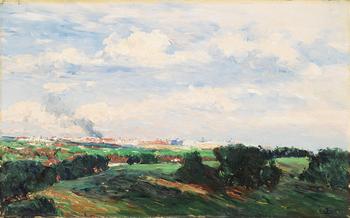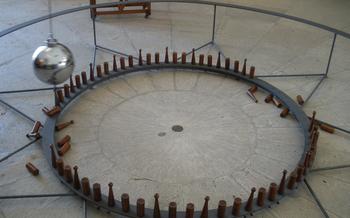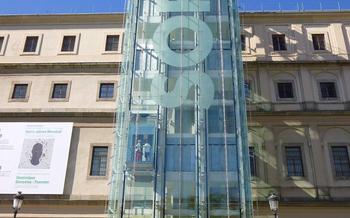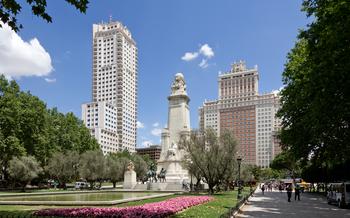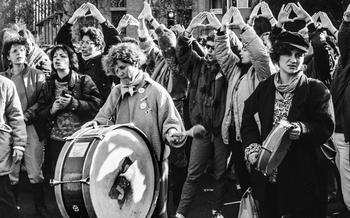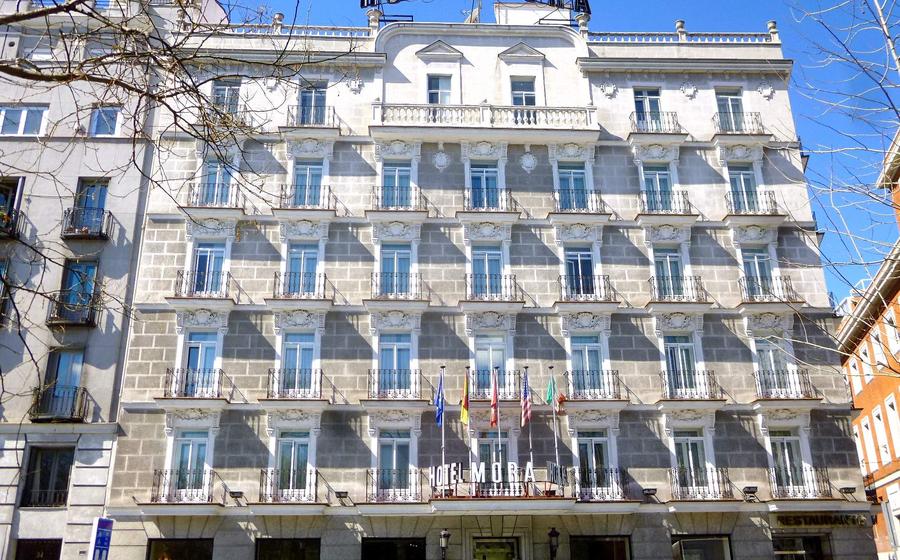
Paseo del Prado
- The Prado Museum: A Masterpiece of Art
- The Thyssen-Bornemisza Museum: A Hidden Gem
- The CaixaForum: A Cultural Center
- The Retiro Park: A Green Oasis
- The Palacio de Cristal: A Crystal Palace
- The Museo Nacional Centro de Arte Reina Sofía: A Modern Art Museum
- The Atocha Railway Station: A Historical Train Station
- The Flea Market at El Rastro: A Treasure Hunter's Paradise
- The San Miguel Market: A Culinary Adventure
- The Plaza Mayor: A Historic Square
- The Royal Palace of Madrid: A Royal Residence
- The Temple of Debod: An Egyptian Temple in Madrid
- Insider Tip: Explore the Hidden Courtyards of the Paseo del Prado
The Prado Museum: A Masterpiece of Art
The Prado Museum is one of the most important art museums in the world, housing a vast collection of paintings, sculptures, and other works of art from the 12th to the 19th centuries. The museum was founded in 1819 by King Ferdinand VII and originally housed the royal collection of paintings. Over the years, the collection has grown to include works from all over Europe, including masterpieces by Goya, Velázquez, El Greco, Titian, and Rubens.
The Prado Museum is a must-see for any art lover visiting Madrid. The collection is vast and varied, and there is something for everyone to enjoy. Highlights of the collection include "Las Meninas" by Velázquez, "The Third of May 1808" by Goya, and "The Garden of Earthly Delights" by Hieronymus Bosch.
To make the most of your visit, plan your route in advance, as the museum is large and it can be easy to get overwhelmed. The Prado Museum offers a variety of guided tours, which are a great way to learn more about the collection and the history of the museum.
Tips:
- Book your tickets online in advance to avoid long lines.
- The museum is open from 10am to 8pm, Tuesday to Sunday.
- Admission is free on weekdays from 6pm to 8pm.
- The Prado Museum is closed on Mondays.
- There are a number of restaurants and cafes in the museum, as well as a gift shop.
- The Prado Museum is wheelchair accessible.
The Thyssen-Bornemisza Museum: A Hidden Gem
The Thyssen-Bornemisza Museum is a hidden gem among Madrid's many art museums. Founded by Baron Hans Heinrich Thyssen-Bornemisza, the museum houses a diverse collection of paintings, sculptures, and other works of art from the 13th to the 20th centuries.
The museum's collection includes works by some of the most famous artists in history, including Caravaggio, Monet, Van Gogh, and Rembrandt. The museum is also home to a number of important works of Spanish art, including "The Annunciation" by Jan van Eyck and "The Dance of the Nymphs" by Nicolas Poussin.
The Thyssen-Bornemisza Museum is a must-visit for any art lover visiting Madrid. The museum's collection is diverse and impressive, and the museum itself is housed in a beautiful building that is worth a visit in its own right.
Highlights:
- "The Annunciation" by Jan van Eyck
- "The Dance of the Nymphs" by Nicolas Poussin
- "The Descent from the Cross" by Caravaggio
- "The Water Lily Pond" by Claude Monet
- "The Starry Night" by Vincent van Gogh
Tips:
-
Take advantage of the museum's free audio guides, which provide insightful commentary on the works of art.
-
The museum is closed on Mondays.
-
The museum is located at Paseo del Prado,
The CaixaForum: A Cultural Center
The CaixaForum is a cultural center located in the heart of Madrid, Spain. It was inaugurated in 2002 and is housed in a former power station, which was transformed into a modern and functional space by the renowned Japanese architect Arata Isozaki. The CaixaForum is dedicated to promoting culture and knowledge through exhibitions, concerts, conferences, and other events.
The center hosts a wide range of temporary exhibitions, covering a variety of topics from art to history to science. Past exhibitions have included "The Age of Impressionism: Masterpieces from the Musée d'Orsay" and "The World of Tim Burton". The CaixaForum also has a permanent collection of contemporary art, which includes works by artists such as Antoni Tàpies, Joan Miró, and Eduardo Chillida.
In addition to exhibitions, the CaixaForum also offers a variety of other activities, such as concerts, conferences, and film screenings. The center has a large auditorium, a library, and a café. It is a popular destination for locals and tourists alike, and it is a great place to learn about Spanish culture and history.
Here are some tips for visiting the CaixaForum:
- Check the CaixaForum's website for upcoming events, as there is always something new to see or do.
- Take advantage of the museum's free audio guides, which provide insightful commentary on the works of art.
- Visit the center's café for a snack or a drink, and enjoy the views of the city from the terrace.
- The CaixaForum is located near the Prado Museum and the Thyssen-Bornemisza Museum, so you can easily visit all three museums in one day.
The Retiro Park: A Green Oasis
The Retiro Park is one of the most beautiful and popular parks in Madrid. It is a great place to escape the hustle and bustle of the city and enjoy some peace and quiet. The park has a long history, dating back to the 17th century, when it was created as a private garden for the Spanish royal family. In the 19th century, the park was opened to the public, and it has been a popular destination for locals and tourists ever since.
The Retiro Park is a vast, sprawling park with something to offer everyone. There are beautiful gardens to explore, with a variety of flowers, trees, and sculptures. There are also several lakes, where you can go boating or fishing. If you are feeling energetic, you can rent a bike and cycle around the park. Or, if you prefer to relax, you can find a shady spot to sit down and enjoy a picnic.
One of the most popular attractions in the Retiro Park is the Palacio de Cristal, a beautiful glass palace that was built in the 19th century. The palace is home to a variety of temporary exhibitions, and it is a popular spot for weddings and other events.
The Retiro Park is a great place to visit at any time of year. In the spring, the park is awash with color, as the flowers are in bloom. In the summer, the park is a great place to cool off, as there are many shady spots to relax. In the fall, the leaves of the trees turn a beautiful golden color. And in the winter, the park is transformed into a winter wonderland, with snow-covered trees and paths.
No matter what time of year you visit, the Retiro Park is a beautiful and peaceful place to spend an afternoon. So if you are looking for a place to escape the hustle and bustle of the city, be sure to add the Retiro Park to your list of places to visit.
The Palacio de Cristal: A Crystal Palace
The Palacio de Cristal is a stunning glass palace located in the Retiro Park. It was built in 1887 for the National Exhibition of Mining, Metallurgy, Ceramics, and Fine Arts. The palace is made of iron and glass, and it is inspired by the Crystal Palace in London.
The Palacio de Cristal is a popular venue for exhibitions and events. It has hosted a variety of exhibitions, including art exhibitions, fashion shows, and concerts. The palace is also a popular spot for weddings and other special events.
If you are visiting the Retiro Park, be sure to visit the Palacio de Cristal. It is a beautiful and unique building that is sure to impress.
Tips:
- Visit the palace at sunset to enjoy the beautiful light filtering through the glass walls.
- Take a guided tour of the palace to learn more about its history and architecture.
- Check the Palacio de Cristal's website for upcoming events.
The Museo Nacional Centro de Arte Reina Sofía: A Modern Art Museum
History
The Museo Nacional Centro de Arte Reina Sofía is one of the most housed in a former hospital, which was built in the 18th century.
Collections
The museum's collection includes works by some of the most famous artists of the 20th century, including Pablo Picasso, Salvador Dalí, and Joan Miró. The museum also has a large collection of works by Spanish artists, such as Antoni Tàpies and Eduardo Chillida.
Highlights
The museum's highlights include Picasso's masterpiece "Guernica," which is a powerful depiction of the bombing of the Basque town of Guernica during the Spanish Civil War. The museum also has a large collection of works by Dalí, including his famous painting "The Persistence of Memory."
Tips
The museum is often crowded, especially on weekends. It is recommended to plan your visit in advance and to purchase tickets online. The museum also offers a variety of guided tours, which can be a great way to learn more about the collection.
The Atocha Railway Station: A Historical Train Station
The Atocha Railway Station is one of the oldest and most important train stations in Madrid. It was built in the late 19th century and is considered one of the finest examples of railway architecture in Spain. The station's stunning architecture is a mix of Moorish and Renaissance styles, and it features a beautiful glass roof that floods the interior with natural light.
Inside the station, you'll find a variety of shops, restaurants, and cafes, as well as a tropical garden that is home to a variety of plants and animals. The garden is a popular spot for travelers to relax after a long journey, and it's also a great place to take a break from the hustle and bustle of the city.
If you're a train enthusiast, you'll definitely want to visit the Atocha Railway Museum, which is located in the station. The museum houses a collection of locomotives, carriages, and other railway artifacts, and it's a great place to learn about the history of Spanish railways.
Whether you're a train enthusiast or not, the Atocha Railway Station is definitely worth a visit. It's a beautiful and historic building that's sure to impress you.
Insider Tip:
If you have time, be sure to take a walk through the nearby Retiro Park. It's one of the largest and most beautiful parks in Madrid, and it's a great place to relax and escape the city noise.
The Flea Market at El Rastro: A Treasure Hunter's Paradise
With a history dating back to the Middle Ages, the flea market at El Rastro is one of the oldest and most popular flea markets in Madrid. Held every Sunday and public holiday, the market takes over the La Latina neighborhood, near the Plaza Mayor, and attracts a diverse crowd of locals and tourists alike.
Stroll through the market's narrow streets and browse the stalls for a variety of goods, including antiques, vintage clothing, jewelry, books, and souvenirs. You're sure to find something unique and special to take home as a memento of your trip to Madrid.
Be prepared to bargain with the vendors, as haggling is expected at El Rastro. Don't be afraid to offer a lower price, especially if you're buying multiple items.
After a morning of shopping, stop for a bite to eat at one of the many bars or restaurants in the La Latina neighborhood. You can enjoy a traditional Spanish lunch, such as tapas or paella, or try one of the many international cuisines represented in the neighborhood.
The San Miguel Market: A Culinary Adventure
Located in the heart of Madrid, the San Miguel Market is a vibrant and bustling culinary haven that has become a popular destination for both locals and tourists alike. Originally built in the 19th century, the market has undergone extensive renovations and has been transformed into a modern and stylish space that retains its historic charm.
Today, the San Miguel Market is home to a diverse array of food stalls, each offering a unique and tempting culinary experience. From traditional Spanish tapas to international cuisine, there is something to satisfy every palate. Visitors can indulge in mouthwatering dishes such as freshly shucked oysters, succulent paella, gourmet cheeses, and artisanal pastries.
In addition to its food offerings, the San Miguel Market is also a great place to sample a variety of drinks. From local wines and craft beers to refreshing cocktails and juices, there is something to quench every thirst. The market's lively atmosphere is perfect for enjoying a glass of wine or beer while savoring the delicious food on offer.
Insider Tip: For a truly unforgettable experience, visit the San Miguel Market in the evening when the market comes alive with locals and tourists enjoying a night out. The market's vibrant atmosphere and delicious food make it the perfect place to experience the culinary delights of Madrid.
The Plaza Mayor: A Historic Square
The Plaza Mayor is one of the most famous squares in Madrid and a must-see for any visitor to the city. It was built in the 17th century and has been used for a variety of purposes over the years, including bullfights, markets, and even executions. Today, the square is a popular tourist destination, lined with shops, restaurants, and bars.
The Plaza Mayor is a beautiful example of Spanish Baroque architecture. The square is surrounded by three-story buildings with balconies and arcades. The center of the square is dominated by a large equestrian statue of King Philip III.
There are many things to see and do in the Plaza Mayor. Visitors can shop for souvenirs, enjoy a meal or drink at one of the many restaurants or bars, or simply relax and people-watch. The square is also home to a number of historical buildings, including the Casa de la Panadería, which is now a museum.
The Plaza Mayor is a great place to visit any time of day, but it is especially beautiful at night when it is illuminated by streetlights. The square is also a popular spot for events and festivals throughout the year.
The Royal Palace of Madrid: A Royal Residence
The Royal Palace of Madrid is the official residence of the Spanish royal family and one of the largest and most beautiful palaces in Europe. It was built in the 18th century on the site of the former Alcázar of Madrid, which was destroyed by a fire in 173The palace is a stunning example of Baroque and Rococo architecture, with a façade that features intricate carvings and sculptures. The interior of the palace is equally impressive, with its grand halls, opulent furnishings, and a vast collection of art and antiques.
Visitors to the Royal Palace can explore the palace's many rooms, including the Throne Room, the Hall of Mirrors, and the Royal Chapel. They can also admire the palace's collection of paintings, sculptures, and other works of art, which includes works by Velázquez, Goya, and other famous artists.
The Royal Palace is a popular tourist attraction, and it is easy to see why. It is a magnificent building that is full of history and culture. Visitors to Madrid should definitely make time to visit the Royal Palace and experience its grandeur for themselves.
Insider Tip
Book a guided tour of the palace in advance to avoid long lines. The tours are available in several languages and provide visitors with a fascinating insight into the history and architecture of the palace.
The Temple of Debod: An Egyptian Temple in Madrid
In the heart of Madrid, nestled within the lush Parque del Oeste, lies a captivating relic of ancient Egypt – the Temple of Debod. This awe-inspiring monument, dating back to the 2nd century BC, was originally located in southern Egypt, near the Nile River. In the 1960s, as part of an international campaign to save cultural heritage threatened by the construction of the Aswan Dam, the temple was dismantled and meticulously reconstructed in Madrid, as a gesture of gratitude for Spain's assistance in the preservation of other Egyptian monuments.
Today, the Temple of Debod stands as a testament to the enduring legacy of ancient Egyptian civilization. Its sandstone blocks, intricately carved with hieroglyphs and reliefs depicting pharaohs, gods, and goddesses, transport visitors back in time to the era of the pharaohs. The temple's serene atmosphere, enhanced by the surrounding gardens and the tranquil waters of the nearby lake, invites contemplation and wonder.
As the sun begins to set, the temple transforms into a magical sight. The warm glow of the evening light illuminates the temple's facade, casting long shadows that accentuate the intricate details of the carvings. From the temple's terrace, visitors can enjoy breathtaking panoramic views of the city, with the Royal Palace and the Casa de Campo in the distance. It's a truly unforgettable experience to witness the ancient temple bathed in the golden hues of sunset, creating a surreal and enchanting ambiance.
The Temple of Debod is a unique and captivating destination that offers a glimpse into the grandeur of ancient Egypt in the heart of Madrid. Whether you're a history buff, an architecture enthusiast, or simply seeking a tranquil oasis amidst the bustling city, the Temple of Debod is a must-visit attraction that will leave you spellbound.
Insider Tip: Explore the Hidden Courtyards of the Paseo del Prado
As you stroll along the Paseo del Prado, be sure to keep an eye out for the many hidden courtyards that are tucked away behind the buildings. These courtyards are often overlooked by tourists, but they offer a glimpse into the history and culture of Madrid.
The courtyards of the Paseo del Prado were once the private gardens of the wealthy families who lived in the area. Today, they are open to the public and offer a peaceful oasis in the midst of the city. The courtyards are filled with beautiful gardens, fountains, and sculptures, and they are a great place to relax and escape the hustle and bustle of the city.
Some of the most beautiful courtyards on the Paseo del Prado include the courtyard of the Palacio de Linares, the courtyard of the Museo Nacional Centro de Arte Reina Sofía, and the courtyard of the CaixaForum. These courtyards are all free to visit and are a great way to experience the hidden side of Madrid.
